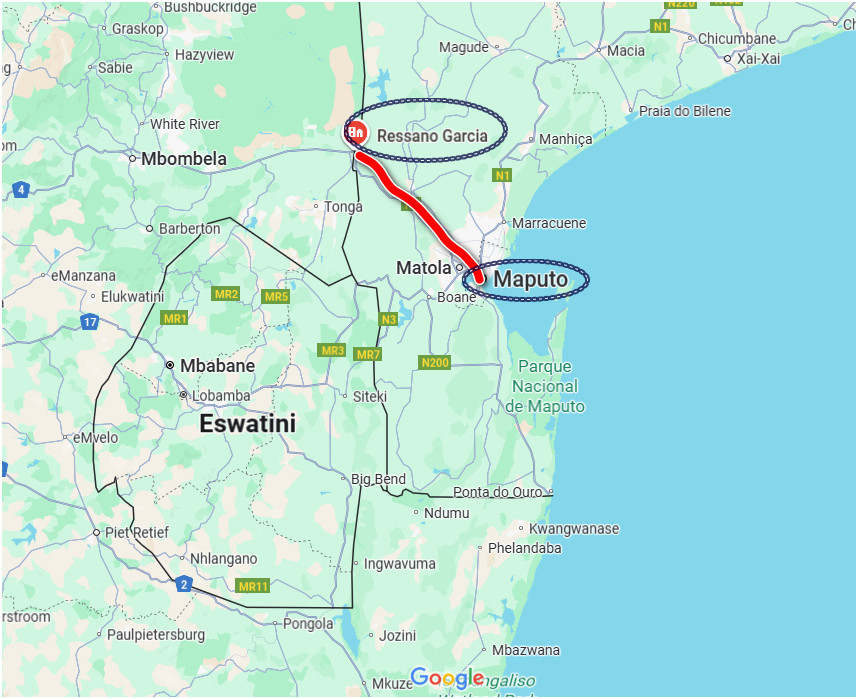The Ressano Garcia Railway in Mozambique
Overview of the Ressano Garcia Railway in Mozambique
The Ressano Garcia Railway, also known as the Pretoria-Maputo Railway or the Maputo Corridor Railway, is a critical transport infrastructure in southern Mozambique, forming a key component of the Maputo Development Corridor. It connects the port city of Maputo (and its industrial suburb, Matola) in Maputo Province to the South African border at Ressano Garcia, facilitating trade with South Africa's economic heartland (Gauteng, Mpumalanga, and Limpopo provinces) and, to a lesser extent, Eswatini. The railway is vital for Mozambique's economy, supporting the export of minerals, agricultural products, and manufactured goods, while enabling imports and regional connectivity for landlocked neighboring countries.
Key Facts and Numbers
Length: Approximately 88–90 km within Mozambique, from Maputo/Matola to the Ressano Garcia border post, with extensions into South Africa (totaling ~500 km to Pretoria).

Gauge: Cape gauge (1,067 mm), standard for Southern Africa, allowing interoperability with South African rail networks.
Capacity: Handles up to 15–20 million tonnes per annum (Mtpa) of cargo, with potential for growth following upgrades. Passenger services are limited, with freight dominating (e.g., coal, chrome, ferrochrome, sugar, citrus).
Operator: Managed by Portos e Caminhos de Ferro de Moçambique (CFM), Mozambique's state-owned ports and railways company, in collaboration with South Africa's Transnet Freight Rail for cross-border operations.
Year Established: Originally built in 1894 during Portuguese colonial rule to link Lourenço Marques (now Maputo) to Pretoria, South Africa. Upgraded multiple times, notably post-independence (1975) and in the 2010s.
Infrastructure: Includes the Maputo Port rail terminal, Matola dry port, and sidings for cargo handling. The line supports both freight and limited passenger trains (e.g., Komati Express, though passenger services are less frequent).
Economic Role
The Ressano Garcia Railway is central to the Maputo Corridor, one of Mozambique's three main economic corridors (alongside Beira and Nacala), contributing significantly to the country's GDP (~$23.77 billion in 2025). It facilitates:
Exports: Minerals (coal, chrome), agricultural products (sugar, citrus), and manufactured goods from Mozambique and South Africa.
Imports: Machinery, consumer goods, and industrial inputs for Mozambique's southern provinces.
Regional Trade: Serves as a gateway for South Africa's Gauteng industrial hub and landlocked regions, reducing reliance on South African ports like Durban. It also supports Eswatini's trade via border connections.
Revenue: Generates foreign exchange through transit fees and port charges, with Maputo Port handling ~30% of Mozambique's cargo volume (20+ Mtpa).
The railway supports the Maputo Corridor's role as a logistics hub within the Southern African Development Community (SADC), fostering post-apartheid regional integration with South Africa. It is critical for industries like mining (e.g., coal from Mpumalanga) and agriculture, with private investments boosting efficiency.
Infrastructure and Operations
Route: Starts at Maputo Port, passes through Matola (a key industrial zone with a dry port), and extends to Ressano Garcia at the Lebombo border crossing, connecting to South Africa's rail network toward Komatipoort and Pretoria.
Upgrades: Significant rehabilitation occurred in the 2000s and 2010s, funded partly by international partners (e.g., World Bank, South African investors). Recent improvements include modernized signaling, track strengthening for heavier loads, and integration with Maputo Port's expansion to handle larger vessels (up to 80,000 DWT).
Freight Focus: Dominated by bulk cargo (coal, minerals, agricultural goods), with daily freight trains. Passenger services are minimal, often overshadowed by road-based chapas (minibuses) or buses on the parallel EN4 highway.
Challenges: Aging infrastructure requires ongoing maintenance, and cyclone damage (e.g., 2019 Cyclone Idai effects on southern routes) can disrupt operations. Coordination with South Africa's Transnet is crucial but occasionally hampered by operational delays or border inefficiencies.
Strategic Importance
Maputo Corridor: The railway is the backbone of this corridor, which includes the EN4 highway and Maputo Port, linking Mozambique to South Africa's industrial and mining regions. It supports ~10–15% of Mozambique's GDP through trade and logistics.
SADC Integration: Enhances Mozambique's role as a gateway for landlocked neighbors, competing with other regional corridors like Beira (to Zimbabwe/Malawi) and Nacala (to Malawi/Zambia).
Investment and Growth: Recent investments (e.g., US$200–300 million in port-rail upgrades in the 2020s) aim to increase capacity to 30 Mtpa by 2030. The corridor attracts private-sector interest from mining companies (e.g., Sasol, for gas-related logistics) and agribusiness.
Economic Diversification: Beyond minerals, the railway supports agro-processing (sugar, citrus) and manufacturing, aligning with Mozambique's National Development Strategy (ENDE) 2025–2044 for sustainable growth.
Current Status (as of September 2025)
Operational: The railway is fully functional, with regular freight services. Recent upgrades have improved reliability, though capacity constraints persist during peak export seasons.
Security: Unlike northern corridors (e.g., Nacala, affected by Cabo Delgado insurgency), the Ressano Garcia line operates in a stable region, with minimal security risks beyond occasional petty crime near Maputo.
Future Plans: CFM plans further modernization, including electrified tracks and increased train frequency, pending funding. Integration with Maputo Port's ongoing dredging and terminal expansions aims to boost competitiveness against Durban and Richards Bay ports.
Challenges: Delays in cross-border coordination, maintenance costs, and competition from road transport (EN4 highway) limit full potential. Community benefits (e.g., 20% revenue sharing per Mining Law) are under scrutiny to ensure local development.
Southern Mozambique Railways: Goba, Limpopo & Ressano Garcia Lines
Mozambique's southern railway system spans key corridors connecting Maputo with Eswatini, Zimbabwe, and South Africa. It includes three major lines:
-
Goba Line (467 km): Connects Maputo to Matsifa in Eswatini, transporting 780,000 tons of cargo and 3 million passengers annually. Operational since 1912, it was modernized in 2022 with border removal to streamline trade.
-
Limpopo Line (900 km): Links Maputo to Samabula, Zimbabwe. Built along the Incomati and Limpopo rivers since 1914, it faced setbacks during the civil war but was restored in the 1990s and 2004.
-
Ressano Garcia Line (88 km): Connects Maputo to South Africa. Modernization efforts, including a €93.3 million investment, have increased freight capacity from 13 to 24 million tons per year.
Together, these lines facilitate regional trade, support both freight and passenger transport, and strengthen economic integration in southern Africa. Despite historical challenges such as war and natural disasters, continued investments ensure the network remains a cornerstone of Mozambique's infrastructure and international trade.
